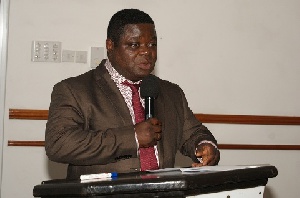 Professor Peter Quartey, Head of the Economics Department, University of Ghana, Legon
Professor Peter Quartey, Head of the Economics Department, University of Ghana, Legon
An economics professor has asked the government and other donor agencies to track the expenditure of resources sent to the Upper West, Upper East and Northern regions (the three northern regions), to ensure that the right people received such assistance.
Professor Peter Quartey, Head of the Economics Department, University of Ghana, Legon, said any such move would help alleviate poverty, but “anything short of this, would pave the way for the elite to muzzle the poor.”
He made the suggestion at the launch of the “Dissemination of the Ghana Poverty Mapping Report” by the Ghana Statistical Service in Accra, on Thursday.
Prof. Quartey noted that though about 90 percent of non-governmental organisations operated in the three northern regions towards poverty reduction, those areas continue to be described as the poorest part of the country.
The Ghana Poverty Mapping report is the second in the series after the first one was published in 2005. The 2005 report captured only the poverty level in the country’s regional capitals, but the current one involve the rate of poverty in the 216 districts across the country.
Mr. Anthony Krakah, head of Industrial Statistics at the Ghana Statistical Service, said that nine out of 10 households in the three northern regions were poor, stressing that it meant each person’s welfare level fell below GH¢1,314.00 per year.
He also cited Wa West, in the Upper West Region with a poverty level of 92.4 per cent, Builsa South in the Upper East Region with 84.4 per cent, East Gonja in the Northern Region with 84.2 percent and Adaklu in the Volta Region with 89.7 percent as the poorest districts in the country.
Mr. Krakah said that some areas in the southern sector of the country were experiencing poverty, and mentioned La Dade Kotopon and Accra Metropolis in the Greater Accra Region.
He said in East Gonja 112,000 persons were below the poverty line, Kpandai 83, 000, the Kumasi Metropolitan Assembly, 88,935 and Wa West 74,000 respectively.
Mr. Krakah said that the Sunyani Municipality in the Brong Ahafo Region was experiencing the highest level of inequality (64.0 percent) in welfare status in the country, whilst Bawku West recorded – 57.9 percent, Garu Tempane – 54.8 percent and Bongo – 54.4 percent.
The Upper Manya District in the Eastern Region had the least level of inequality in welfare status – 27.2 per cent but La Dade Kotopon Municipality which has the least poverty level is rather highest in terms of inequality status.
Launching the report, Dr. Philomena Nyarko, Government Statistician, urged the assemblies and stakeholders to use the document to plan for the development of their respective areas to reduce poverty.